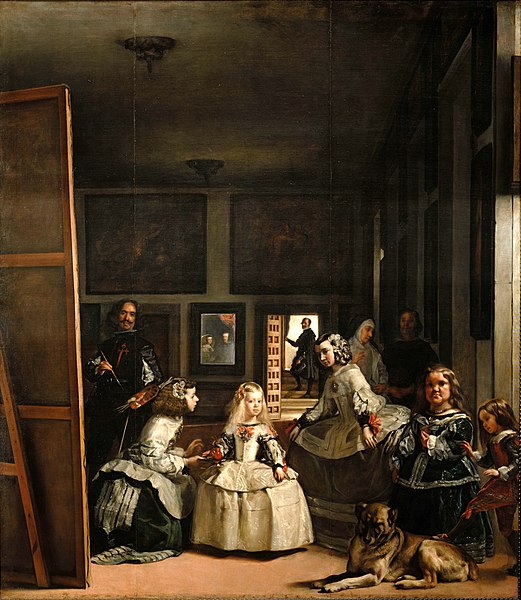All AP Art History Resources
Example Questions
Example Question #551 : 2 D Art
The Dutch painter who made highly stylized portraits of the English King Charles the First and his family was __________.
Rembrandt van Rijn
Anthony van Dyck
Hieronymus Bosch
Johannes Vermeer
Anthony van Dyck
Anthony van Dyck was born in the Netherlands in 1599, but moved to Italy to study art in 1621 and became the official court painter in London in 1632. Van Dyck performed the normal function of a court painter by painting portraits of the royal family and associated people, but in a beautiful style. Van Dyck also made interesting compositional choices, such as his portrait of King Charles with three different profiles of the monarch in one painting.
Example Question #431 : Renaissance To Contemporary 2 D Art
Each of these paintings was made by the court painter to a King of __________.
England
France
Spain
Italy
Spain
Both of these paintings are images of a Spanish Royal Family, set some one hundred and fifty years apart. They are connected by more than location, however, as Diego Velázquez' Las Meninas (1656), shown in Figure 1, was such a famous and influential painting that Francisco de Goya intentionally modeled his 1801 painting Charles IV of Spain and His Family, shown in Figure 2, on the earlier work. Each painting shows the Royal Family of Spain in a relaxed and somewhat informal pose in a natural setting.
Figure 1: Las Meninas by Diego Velázquez (1656)
Figure 2: Charles IV of Spain and His Family Francisco de Goya (1801)
Example Question #432 : Renaissance To Contemporary 2 D Art
The official court painter of King Philip IV of Spain, who ruled from 1621 until 1665, was __________.
Diego Velazquez
Peter Paul Reubens
El Greco
Francisco de Goya
Diego Velazquez
Philip IV ruled Spain and its territories and colonies when it was the largest power on the globe, during the seventeenth century. Philip IV wished to present himself as a magnificent figure, and he hired the best painter in Spain, Diego Velazquez. Velazquez's portraits of the royal family and its attendants conveyed their wealth and prestige, along with an inner psychology that made Velazquez one of the masters of Baroque painting.
Example Question #433 : Renaissance To Contemporary 2 D Art
The Flemish artist who painted a cycle of works for Marie de Medici, Queen of France, was __________.
Johannes Vermeer
Rembrandt van Rijn
Peter Paul Ruebens
Anthony Van Dyck
Peter Paul Ruebens
The Marie de Medici Cycle was a series of twenty four paintings dedicated to, and depicting, the life of the Queen of France, Marie de Medici. Commissioned in 1621, and completed within three years, the massive project was given to the Flemish painter Peter Paul Reubens, who had already done portraits of many of the queen's relatives. Reubens' many portraits and canvases in the cycle are one of the landmarks of Baroque painting.
Example Question #434 : Renaissance To Contemporary 2 D Art
The Spanish court painter to King Philip IV, famous for the painting of the royal family known as Las Meninas, was __________.
Diego Velázquez
Bartolomé Esteban Murillo
Francisco de Zurbarán
Juan Sánchez Cotán
Diego Velázquez
Diego Velazquez's Las Meninas is one of the most well-respected paintings in history, with artists as diverse as Thomas Gainsborough, Édouard Manet, and Pablo Picasso citing it as a major influence. Velazquez's painting is borne out of his role as court painter to the Spanish King Philip IV, as the King's daughter is the main subject, but she is shown with various attendants and even the painter himself. Remarkably for his time, the subjects are shown in full humanity and the brushstrokes are relatively impressionistic.
Example Question #563 : Ap Art History
The Italian transitional painter who produced two different paintings depicting the supper at Emmaus is __________.
Gian Lorenzo Bernini
Michelangelo
Titian
Caravaggio
Caravaggio
Caravaggio was a significant transitional figure between the Mannerist style and the Baroque style, despite having a career that only lasted from 1592 to 1610. Caravaggio used dramatic changes between light and dark, known as "chiaroscuro," to highlight emotional moments and painted with vivid color. In Caravaggio's two paintings of The Supper at Emmaus, he uses these techniques to highlight the surprise of Jesus' disciples when the risen Christ reveals himself to them on the road to Emmaus.
Example Question #564 : Ap Art History
The works of painters from the Dutch Golden Age included all of the following types, EXCEPT __________.
biblical scenes
landscapes
portraits of saints
historical paintings
portraits of saints
The Dutch Golden Age refers to the era of the mid-seventeenth century when the Dutch Republic had its most clout in trade, foreign affairs, and culture, especially in the realm of visual art. The great Dutch masters of the time include Johannes Vermeer, Frans Hals, Jan Steen, and Rembrandt van Rijn, who all produced striking portraits, landscapes, and history paintings with vivid colors and remarkable use of light. Not popular among these painters were images of saints, as the Netherlands had become mostly Protestant and Calvinist.
Example Question #3 : Identifying Artists, Works, Or Schools Of Seventeenth And Eighteenth Century 2 D Art
The painter who commemorated a Spanish victory over the Dutch in the 1625 painting The Surrender of Breda was __________.
Juan Bautista Maino
Caravaggio
Diego Velazquez
Peter Paul Rubens
Diego Velazquez
The Spanish victory at Breda was a rare success for Spanish troops over the Dutch in the Eighty Years' War. The moment was commemorated by the court painter to King Philip IV, Diego Velazquez. The life-size painting shows the Dutch surrender, which glorifies the Spanish troops and shows the Spaniards as both victorious and magnanimous. This painting also serves as a prime example of Velazquez' great skill with color and composition.
Example Question #561 : 2 D Art
Who was the painter of the odd court painting Las Meninas?
Diego Velazquez
Raphael
El Greco
Titian
Hans Holbein
Diego Velazquez
Diego Velazquez was an idiosyncratic painter who became the offical court painter for the Spanish king Philip IV. Velazquez's unique composition style, love of odd subjects, and expressive portrait style found its culmination in Las Meninas, a 1656 painting that shows the daughters of the King with their attendants and the painter in a large room with people coming and going. The painting was so remarkable that Pablo Picasso made a cubist version of it in the twentieth century.
Example Question #1 : Analyzing The Content Of 2 D Visual Art
Markers of the artistic style of the Dutch painter Rembrandt van Rijn (1606-1669) include all of the following EXCEPT __________.
large-form landscapes
the insertion of himself into his group paintings
dramatic use of lighting
portraits of individuals
a use of very rich and dark colors
large-form landscapes
Rembrandt van Rijn was one of the great masters of the Dutch Golden Age of painting during the seventeenth century. His style was notable for featuring bold colors and dramatic lighting in "everyday scenes" of commonfolk, as well as portraits and scenes out of the Bible. Almost all of Rembrandt's paintings featured people, and he almost never drew landscapes.
Certified Tutor
All AP Art History Resources





